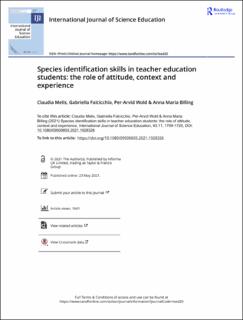Species Identification Skills in Teacher Education Students: The Role of Attitude, Context and Experience
Peer reviewed, Journal article
Published version
Permanent lenke
https://hdl.handle.net/11250/2983709Utgivelsesdato
2021-05-23Metadata
Vis full innførselSamlinger
- Artikler (Articles) [173]
- Publikasjoner fra Cristin - DMMH [138]
Originalversjon
International Journal of Science Education. 2021, 1-17. 10.1080/09500693.2021.1928326Sammendrag
Knowledge about local species and a positive attitude towards all living organisms are important to motivate the next generations to protect biodiversity. We compared local species identification skills and declared attitude towards invertebrates across genders in Italian and Norwegian students in teacher education. We focused on Norway and Italy for this comparative study, because of their different teaching traditions and relationships with outdoor education. We found a significant difference in local species identification skills between Italian and Norwegian students, who could identify 21% and 57% of the species, respectively. Overall, females had a more negative attitude towards invertebrates than males. However, Norwegian women had a more positive attitude towards invertebrates than Italian women did. Our result could reflect both differences in time spent in nature and teaching programs between countries. We also found a positive correlation between species identification skills and declared interest towards invertebrates. We discuss several approaches that could help to address this issue, in order for future teachers to become more aware of the risk that their biophobic attitude is transferred to the next generation with negative effects on biodiversity conservation.

